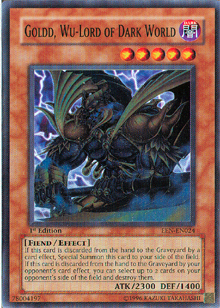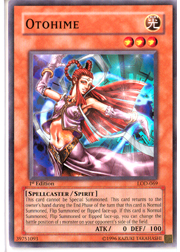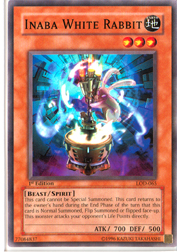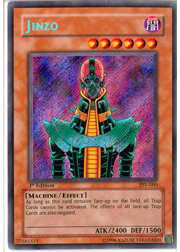
One of my favorite cards in the Yu-Gi-Oh! TCG also has the potential to be one of the worst, and that’s D. D. Designator. Here’s a little refresher on this spell card’s effect:Declare 1 card name. Look at your opponent's hand, and if they have the declared card in their hand, remove from play that 1 card. If they do not have the declared card in their hand, remove from play 1 random card in your hand.
I’m hard-pressed to think of a card that can backfire so horribly as this one. Usually when a single card of yours goes awry, the worst that can happen is that you’ll lose that particular card. This one actually takes another card with it, not just sending it to the graveyard (where it can be delicious fodder for Chaos Sorcerer or Pot of Avarice), but sending it clean out of the game. Rough beats.
Ah, but at the same time, D. D. Designator can reward a truly skilled player with many advantages. Knowledge of the opponent’s options, hand disruption without the life point cost of Confiscation, and the ability to limit the opponent’s actions without risking the discard of Goldd, Wu-Lord of Dark World. Skill in reading the opponent’s hand is key. Did he or she just draw for the turn and search the graveyard for a Light monster and a Dark monster, telegraphing Chaos Sorcerer? Did he or she go first and not set a monster, betraying Cyber Dragon? A good player can turn those moves into valuable information, and then use D. D. Designator accordingly.
But of course, sometimes skill isn’t enough. There are plenty of ways to stack the odds in Designator’s favor, everything from waiting for the opponent to use Magical Merchant, Magician of Faith, or Sangan, to running other cards that let you see your opponent’s hand. I’ve actually built entire decks around this concept, but I never hit on one that I was really satisfied with. Luckily, today’s deck submitter succeeded where I failed. Check it out.
Hello, Jason,
My name is Charlie, I'm from Bowling Green, Kentucky. I was looking around on a forum for new deck ideas, because I'm just tired of running my Chaos Return deck all the time, and I found a card called Exchange that I remembered from a long time ago. The post it was being mentioned in was titled "Exchange and Horus," and nearly every post in the topic read, "Exchange sucks, don't even use it," or something to that degree.
I looked through my cards and found that I could actually build a very viable deck based on Exchange, and when I built the prototype and tested it against my friend and fellow creator, it absolutely dominated. It's based on getting to know your opponent's hand and getting rid of it fast, by using cards like D. D. Designator and Mind Crush alongside monsters such as Don Zaloog and Spirit Reaper. I threw in a couple Spirit monsters because if my opponent takes one with Exchange (which I can usually force them to do), it will bounce to my hand when they summon it and is basically a free card.
Also, I put in three copies of Mystic Tomato to go through the deck quicker, and if my opponent gets one of those with Exchange, I can just destroy it and gain huge field presence. Goldd, Wu-Lord of Dark World is in here to combo with Confiscation and my discarding monsters to give me absolute advantage, because it is yet another card that, if taken with Exchange, benefits me.
I know it has some problems with it, but I'm not entirely sure what they are, so I just wanted you to take a look and maybe help me out. Thanks!
—Charlie S.
Bowling Green, Kentucky
While I’d tried running Exchange to support D. D. Designator before, I’d been going about the problem all wrong, building a Designator deck instead of an Exchange deck. Spirit monsters, Mystic Tomato, and Goldd, Wu-Lord of Dark World make the idea work. Check out the decklist.
Exchange Control
40 Cards
 Monsters: 18
Monsters: 18
2 Magician of Faith
2 Otohime
2 Asura Priest
1 Tsukuyomi
2 Goldd, Wu-Lord of Dark World
2 Spirit Reaper
3 Mystic Tomato
2 Don Zaloog
1 Sangan
1 Breaker the Magical Warrior
Spells: 15
3 Exchange
1 Confiscation
2 D. D. Designator
1 Graceful Charity
1 Heavy Storm
1 Premature Burial
2 Nobleman of Crossout
2 Smashing Ground
1 Snatch Steal
1 Mystical Space Typhoon
Traps: 6
2 Mind Crush
1 Mirror Force
1 Torrential Tribute
1 Call of the Haunted
1 Threatening Roar
It actually took me a while to figure out how to improve on Charlie’s build. I initially sent him a reply saying I loved the deck, but had no idea how to fix it, since I hadn’t played it myself. That was a couple weeks ago, and I’ve now got a very clear idea of where the deck can be improved. This fix is pretty weird, so you’re going to have to trust me and keep reading. I think this is the first Apotheosis where I’ve actually decided to make a deck significantly larger.
Right now, the only weak cards in the deck are Otohime and Threatening Roar. Otohime is a decent defensive monster when you set it, blocking one attacker in battle and then turning another to defense position to prevent it from attacking. In addition, it can be really useful if the opponent activates Scapegoat or happens to be running Treeborn Frog. With that said, though, the card’s utility is relatively low, and I’d probably only want to use it if I knew my opponent was running both Scapegoat and Treeborn Frog. Despite being able to turn high ATK monsters to defense position, it was usually a dead draw in my testing, and its hideous stats (0 ATK and 100 DEF) meant that as an opponent learned the deck, Otohime would often be getting taken off the field by stuff like Magical Merchant. Sadness.
 We’ll need to find a replacement Spirit monster to fill the strategic gap left behind by the pair of Otohime, which I’ll be banishing to the side deck. This card’s got a surprising amount of potential for something that can look so terrible, but it’s better as a surprising win for game 2 than a dead draw in game 1.
We’ll need to find a replacement Spirit monster to fill the strategic gap left behind by the pair of Otohime, which I’ll be banishing to the side deck. This card’s got a surprising amount of potential for something that can look so terrible, but it’s better as a surprising win for game 2 than a dead draw in game 1.
Next, I’m going to remove the one copy of Threatening Roar. Roar is cool in this deck because it accomplishes virtually nothing when given to the opponent with Exchange—it just holds you off for a turn. You’re not running Cyber-Stein or Return from the Different Dimension yourself (which are the cards that get destroyed by Threatening Roar), so you don’t feel much of an impact when the opponent has it set. But I need some wiggle room, and I usually shy away from cards that are useless when I’m winning. This deck maintains board presence really well thanks to Mystic Tomato and Reaper, so I just don’t see Roar as a main deck pick. Again, I’m going to suggest that it be bumped to the side deck.
I’m down to 37 cards. Normally I’d add three, maybe four cards to the deck and call it a day, but this time I’m going to do something a little bit different. I’m going to take the list all the way up to 45 cards. Hopefully the reason why will become clear nice and quick, because I’m sure my mathematical heresy is making me look a little crazy at the moment.
 First up, I need to replace that pair of Otohime, so in go a pair of Inaba White Rabbit. This card is somewhat underrated in a general sense, but it’s especially good here. Exchange Asura Priest to the opponent and he or she can wreck your field if you haven’t played carefully: Asura can shred your Tomatoes, and even though you’ll get Asura back at the end of the turn, it can lead to losses. Inaba can’t do that. The worst thing an opponent can do with it is strap it with United We Stand and smash you for a ton of damage, but very few duelists run equips and even if he or she does, hey, he or she loses the equip spell when Inaba comes home to its rightful owner. This card does nothing for your opposition.
First up, I need to replace that pair of Otohime, so in go a pair of Inaba White Rabbit. This card is somewhat underrated in a general sense, but it’s especially good here. Exchange Asura Priest to the opponent and he or she can wreck your field if you haven’t played carefully: Asura can shred your Tomatoes, and even though you’ll get Asura back at the end of the turn, it can lead to losses. Inaba can’t do that. The worst thing an opponent can do with it is strap it with United We Stand and smash you for a ton of damage, but very few duelists run equips and even if he or she does, hey, he or she loses the equip spell when Inaba comes home to its rightful owner. This card does nothing for your opposition.
At the same time, it can do a ton of things for you. Because this deck can lock up the field with Tomato and Reaper, you can sit back and establish a slow tempo. Your opponent will often welcome that, because they’ll be down in cards and will want any extra draw phases you’ll give them. At the same time, Inaba can nibble away 700 life points a turn and slowly win the game. Heck, it even gets around Spirit Reaper, and it sneaks under Gravity Bind, Messenger of Peace, and Level Limit – Area B.
And it lets you trigger Robbin’ Goblin, of which we’re adding two copies.
Robbin’ Goblin can be incredible in this deck, giving you another way to discard your Goldds from the opponent’s hand and shrink his or her options for the following turn. At the same time, it provides a double-pronged advantage, because of the deck’s ability to maintain field presence. On one hand, you’ll often be able to attack the opponent directly, simply because you’ll control more monsters than he or she does. On the other, if you Exchange a Goblin to the opponent, he or she usually won’t be able to do anything with it, simply because you’ll have Tomatoes, Reapers, and Tsukuyomi to defend your life points. Inaba becomes a Spirit Reaper that attacks through your opponent’s monsters, and Asura Priest loves it, too. It really puts this deck over the top.
I’ve added four cards, leaving this deck with 41 total. Like I said, I’d normally cut the fix here, and if you’re interested in running the deck, by all means feel free to test the 41-card build against the 45-card build. Who knows, maybe you’ll prefer it.
But for me, I think the next step with the deck is clear. Exchanging a Mystic Tomato to your opponent is brutal, and I want to add another option that follows that philosophy: Nimble Momonga. With Reaper back at three copies in many competitive decks, I’m starting to test this card in basically everything I build just to see how it works out, and it’s surprisingly good in several different strategies. In this deck, it’s more Exchange fodder and more potential attackers to push through discards with Robbin’ Goblin. It gives you another way to halt early aggression before you can simplify the field by making trades with Mind Crush and Designator, and once you do reduce the number of cards on the field, its 1000 ATK starts adding up. It’s free tribute fodder to make Goldd, Wu-Lord of Dark World a bit more useful, and it’s probably the best card in the game to support Pot of Avarice.
 Speaking of which, the final card I’ll be adding here will be Pot. of Avarice. In the early game it’s the safest thing to Exchange to an opponent, turning your useless card into their useless cards, and giving you a potentially good one in return. In the mid- and late game it can still be totally useless if the opponent is playing Return. No monsters left in the graveyard because you were bringing out Sorcerers earlier? Aww, too bad. Better yet, go ahead and use the Pot. I bet you didn’t like Return anyway, right?
Speaking of which, the final card I’ll be adding here will be Pot. of Avarice. In the early game it’s the safest thing to Exchange to an opponent, turning your useless card into their useless cards, and giving you a potentially good one in return. In the mid- and late game it can still be totally useless if the opponent is playing Return. No monsters left in the graveyard because you were bringing out Sorcerers earlier? Aww, too bad. Better yet, go ahead and use the Pot. I bet you didn’t like Return anyway, right?
Meanwhile, Pot of Avarice lets you keep the monsters coming while being liberal with your blocking plays. It gives you extra cards while you’re stripping them away from the opponent. Having two cards to your opponent’s one is very different from having six to his or her five.
The best part is that even though this build is now 45 cards strong, nine of them thin at least one additional card from the deck. The bigger deck size gives you better odds of not drawing two Momongas early on, and once a few thinners bite the dust, you’ve got an average deck size and monster/spell/trap ratio. It’s outside the box, but it works.
Here’s the final list of changes I made to Charlie’s deck.
-2 Otohime
-1 Threatening Roar
+2 Inaba White Rabbit
+3 Nimble Momonga
+1 Pot of Avarice
+2 Robbin' Goblin
The finished build is as follows.
Exchange Control: Jason’s Fix
45 Cards
 Monsters: 21
Monsters: 21
2 Magician of Faith
2 Inaba White Rabbit
2 Asura Priest
1 Tsukuyomi
2 Goldd, Wu-Lord of Dark World
2 Spirit Reaper
3 Mystic Tomato
2 Don Zaloog
1 Sangan
1 Breaker the Magical Warrior
3 Nimble Momonga
Spells: 16
3 Exchange
1 Confiscation
2 D. D. Designator
1 Graceful Charity
1 Heavy Storm
1 Premature Burial
2 Nobleman of Crossout
2 Smashing Ground
1 Snatch Steal
1 Mystical Space Typhoon
1 Pot of Avarice
Traps: 7
2 Mind Crush
1 Mirror Force
1 Torrential Tribute
1 Call of the Haunted
2 Robbin’ Goblin
The deck can start off a bit slow, but it opens really well. Sangan, Tomato, Momonga, and Reaper are all great opening plays for when you go first. That’s nine cards total, so you’ll usually have at least one in your opening hand.
While a slow tempo might be good for the first few turns, you want to establish a neutral tempo* as quickly as possible. That’s because when you start discarding cards with Mind Crush and Designator, you want the end result to be a simplification of the duel—you’re trying to create a situation where each player only controls a few cards. Then, every time you exchange a Tomato, Momonga, or Asura Priest, your opponent is really going to feel it. You won’t gain card advantage per se, because the opponent takes your card when they lose theirs to Exchange. In fact, you lose a card to the graveyard, the Exchange itself, in the process of doing so. But the blind math doesn’t matter. What counts is that the card you took from the opponent is a potentially useful one, while you stuck them with something that ranges from “bad” (a card they simply don’t want to use, like a Spirit) to “worse,” like Tomato, Momonga, or Goldd, Wu-Lord of Dark World, which will feed you monsters in the long run.
While the deck can win simply by virtue of its superior field presence and its hand control, Robbin’ Goblin warrants special mention. Clear the field, make a few good attacks with Goblin-powered lightweights, and watch the opponent panic. Using “Robbin’ Inaba” as a poor man’s Yata-Garasu is just priceless, and flipping Magician of Faith, taking back D. D. Designator with its effect, using it to strip the opponent of a card, and then hitting him or her with the Magician to discard another is ridiculous.
This deck makes stupid-good plays like that all the time.
 Priorities for theft and removal depend on the matchup, but Jinzo is always your number-one target unless the opponent has something that seriously threatens your established infrastructure. Chaos Sorcerer is an amazing card to Designate or Mind Crush, because no matter what you do to it, you basically eliminate it from play, and if you can deprive the opponent of two Sorcerers, you’ll often make Return a dead card. If you have Goblin out, defend it like crazy and use your hand control to clear a path for attack. If not, just pick whatever seems good at the time. An Exchanged Goldd is a great default, but Smashing Ground and Sakuretsu Armor rank pretty high on the list, since they can cause problems for your Tomatoes and Momongas. Experiment with the deck and see what works for you.
Priorities for theft and removal depend on the matchup, but Jinzo is always your number-one target unless the opponent has something that seriously threatens your established infrastructure. Chaos Sorcerer is an amazing card to Designate or Mind Crush, because no matter what you do to it, you basically eliminate it from play, and if you can deprive the opponent of two Sorcerers, you’ll often make Return a dead card. If you have Goblin out, defend it like crazy and use your hand control to clear a path for attack. If not, just pick whatever seems good at the time. An Exchanged Goldd is a great default, but Smashing Ground and Sakuretsu Armor rank pretty high on the list, since they can cause problems for your Tomatoes and Momongas. Experiment with the deck and see what works for you.
Some weeks, I fix Legendary Jujitsu Master decks, but other weeks, I show you serious contenders for the current Advanced format. This is one of the latter. As always, practice is the key: this is far different from a brainless Chaos Return build that plays on autopilot 90 percent of the time. It can be mentally fatiguing, but opponents will find it incredibly hard to play against the first time you whip it out, making it a great choice for Regional competition. If you really put the time in to learn how the deck works, and maybe tweak it a little for your personal tastes, it can win tournaments.
Remember, Exchange was reprinted in Dark Beginnings 1, so if you don’t have the old promo version, you can probably pick up a playset of the super rare on the cheap! Hopefully the fix brings everything together for Charlie, and hopefully you give this deck a shot yourself.
—Jason Grabher-Meyer
*That’s where each duelist is losing one card per turn, matching their one draw, so nobody’s actually gaining anything in the long run.